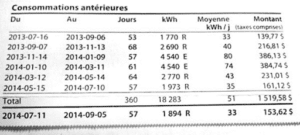comparative study…
It’s fantastic: a free source of energy! During the winter, it can heat your home by drawing heat from the ground. During the summer, it cools it and removes excess humidity. This system can save you up to 70% of costs from electric heating.
So how does it work?
Geothermal systems take advantage of the stability of the gA round temperature. Underground pipes carry a fluid and heat energy is transferred from the ground to the fluid and then to the geothermal unit in the home, giving warmth to the structure. Inside, the heat is then distributed through a conventional duct system or a hydronic radiant heating system.
The loops can be vertical or horizontal and are made of durable, high-density polyethylene, and are buried in the earth or submerged in a lake or pond. The type of loop depends on the size and configuration of the terrain.
A geothermal system is more efficient than regular heating and air conditioning systems as they can deliver four units of energy for every one unit of electrical energy used.
Installation costs
For a standard home, the cost of a geothermal system varies between $25,000 and $40,000. The capacity of the unit is calculated in tons at a price of $8,000 /ton. Normally, a home will require a 3-ton unit.
The costs are divided roughly into three equal parts: 1- drilling ans underground circuit installation costs, 2- interior equipment costs and 3- labor.
The depth of drilling depends on the amount of heat needed – according to the size of the home and the quality of its insulation – and on the soil conditions.
For a home heated with oil and a forced air system, the ductwork is already in place and often adequate for a geothermal system.
Maintenance and longevity
For an indoor geothermal heat pump, the life expectancy can be of up to 25 years, compared to 13 to 15 years for regular air conditioners and heat pumps. The underground circuits can withstand 50 years.
As far as maintenance is concerned, the geothermal system will require little or no maintenance besides regular checks and monthly filter changes.
COMPARATIVE STUDY

Year of construction: 2012
NovoClimat construction
• Total surface = 3,950 sq ft (368 m²)
• Basement = 1,450 sq ft (135 m²)
• 1st floor = 1,450 sq ft (135 m²)
• 2nd floor = 610 sq ft (57 m²)
• Garage = 440 sq ft (41 m²)
• Heating load:
• Basement /1st floor/2nd floor = 65,000 BTU/h (19 kW)
• Installed capacity = 4.5 tons (1 x 3T water-air & 1 x 1.5T water-water)
• Soil = average rock
• Vertical closed loop configuration = 640’ (2x 320’) or 195m (2x 97m)
Highlights:
• Basement & garage with radiant floor heating
• Annual electricity operating costs = $1,592 ($18,283 kWh/year)
• Annual heating consumption = 10,723 kWh or 29 kWh/m² → 70% less than average
• Hydro Québec annual average:
• Annual average heating consumption = 93 kWh/m²
• Energy for domestic hot water = 1,780 kWh/year per person
• Annual average consumption for other appliances = 4,000 kWh/year

FOUR RESIDENCE COMPARATIVE
1107 BELLEVUE L’ILE-BIZARD QC
• Estimated annual bill $2,050.00 (taxes incl.)
• Approximately 22,970 kWh per year
1111 BELLEVUE L’ÎLE-BIZARD QC
• Estimated annual bill $4,410.00 (taxes incl.)
• Approximately 48,120 kWh per year
1115 BELLEVUE L’ÎLE-BIZARD QC
• Estimated annual bill $2,060.00 (taxes incl.)
• Approximately 23,400 kWh per year
1117 BELLEVUE L’ÎLE-BIZARD QC
• Estimated annual bill $2,300.00 (taxes incl.)
• Approximately 25,830 kWh per year
► Average of the 4 homes on Bellevue Street = $2,705.00 (taxes incl.)
This annual costs above are estimated based on electricity consumption at these addresses during the past twelve months and the temperature recorded in the region in recent years. Future costs may be different from those of current occupants due to various factors, such as number of occupants, heating habits or electrical appliances used.
–Source: Marc Bélanger, geoexpert.info

